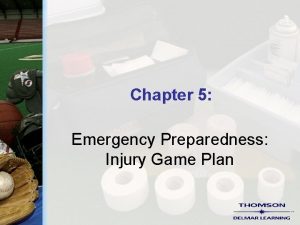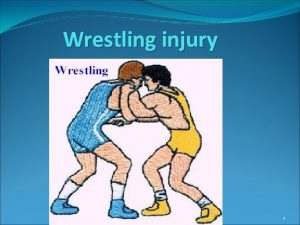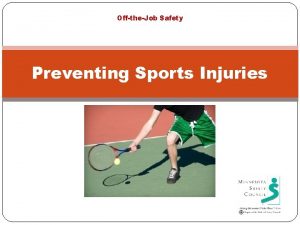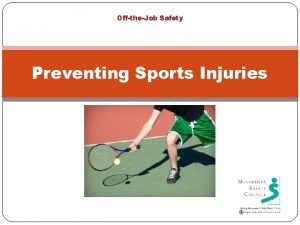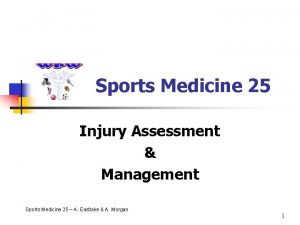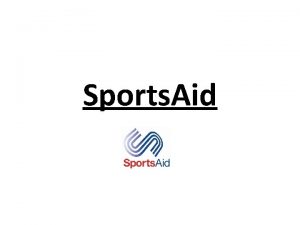Chapter 1 The Concept of Sports Injury Sports








![Catastrophic Injury [Mueller and Cantu (2009)] • Severe injury incurred during participation in a Catastrophic Injury [Mueller and Cantu (2009)] • Severe injury incurred during participation in a](https://slidetodoc.com/presentation_image_h/c29167b476de120420187c1d3315ae37/image-9.jpg)




























- Slides: 37

Chapter 1 The Concept of Sports Injury

Sports Participation • In the United States, 7. 5 million public high school children are involved in sports activities annually (National Federation of State High School Associations (NFHS)) • Approximately 30 million school aged children participate (Adirim & Cheng, 2003). © Ilene Mac. Donald/Alamy Images

Title IX Education Assistance Act of 1972 • In the 1980 s, female sports participation increased by 700%. • From 1998 -2008 colleges added 2755 new women’s teams. (http: //www. acostacarpenter. org) • In 2002 renamed the Patsy T. Mink Equal Opportunity in Education Act © Shawn Pecor/Shutter. Stock, Inc.

Sports Injury • Injury continues to be an unavoidable reality for a significant number of participants. • Of 1421 injuries reported to four hospital emergency rooms over two 1 -month periods, 41% were attributed to sports participation. [Damore and colleagues (2003)]. • sprains, contusions, and fractures were the most common injuries.

Definition of Sports Injury • There is no universally acceptable definition but most involve time lost. • National Collegiate Athletic Association (NCAA) Definition of Sports Injury: • Occurs as a result of participation in organized intercollegiate practice or game. • Requires medical attention by a team athletic trainer or physician. • Results in restriction of athlete’s participation for one or more days after the injury.

General Injury Data • Typically expressed as the rate of injury per 100 athlete exposures 1. 2. 3. 4. Soccer 2. 1 Baseball 1. 7 Football 1. 5 Softball 1. 0 • In all sports, there were more injuries in games than in practice. • Contusions are the most common. Radelet and colleagues (2002) © Photos. com

Injury data related to gender • Available evidence suggests that for some sports the injury rates are higher for girls while in other sports the rates are higher for boys. • Data for basketball, soccer and baseball/softball indicates that the aggregate rate for boys sports was higher than for girls. (Darrow et al, 2009) • But girls were found to have a much higher rate of knee ligament sprains in soccer. (Yard et al, 2008) • High school data indicates that in basketball, girls sustained more concussions and knee injuries while boys sustained more fractures and contusions. (Borowski et al, 2008)

Characteristics of Sport Injury • Once an injury is identified, several qualifiers are available to enable sports medicine personnel to better describe the precise characteristics of the injury. • Catastrophic vs. Non-catastrophic • Time frame of injury • Acute, Chronic, and Overuse • Type of tissue(s) involved and injury location
![Catastrophic Injury Mueller and Cantu 2009 Severe injury incurred during participation in a Catastrophic Injury [Mueller and Cantu (2009)] • Severe injury incurred during participation in a](https://slidetodoc.com/presentation_image_h/c29167b476de120420187c1d3315ae37/image-9.jpg)
Catastrophic Injury [Mueller and Cantu (2009)] • Severe injury incurred during participation in a school/college sponsored sport. • Recently, wrestling, gymnastics, ice hockey, baseball, and track are receiving the most attention. • Can be life threatening or cause permanent damage. • Can occur as a direct or indirect result of sports participation. • Direct – Results directly from participation in sports. Brain and spinal cord injuries are most common • Indirect - Systemic failure resulting from exertion or by a complication that was secondary to a nonfatal injury. Heat illness, cardiomyopathies, and sickle cell anemia are most common.

Acute Injuries Acute Injury – “characterized by rapid onset, resulting from a traumatic event” (AAOS, 1991) • Typically involve significant trauma followed by pain, swelling, and loss of function. Trauma to create acute injury • Critical Force – “magnitude of a single force for which the anatomical structure of interest is damaged” (Nigg & Bobbert, 1990)

Chronic Injuries Chronic Injury – “characterized by a slow, insidious onset, implying a gradual development of structural damage” (AAFP, 1992) • Chronic injuries develop over time and are often associated with repetitive, cyclic activities. • These injuries are commonly called overuse injuries. Often result from eccentric contractions. • Common sites include the Achilles tendon, patellar tendon, and the rotator cuff tendons.

Overuse Injuries Overuse injuries may be caused by: 1. Intrinsic Factors – immature cartilage, lack of flexibility, lack of proper conditioning, psychological factors. 2. Extrinsic Factors – excessive training, lack of adequate recovery, incorrect technique, playing on uneven or hard surfaces, incorrect equipment (i. e. , shoes or rackets)

Types of Tissues Soft Tissues • Muscles • Fascia • Tendons • Joint capsules • Ligaments • Blood vessels • Nerves • Skeletal Tissue • Bony structures in the body

Injury Classifications Sprains are injuries to ligaments. • First-degree: mild pain with little/no swelling • Second-degree: ligament damage, pain, moderate swelling, and dysfunction • Third-degree: complete tear of ligament(s), pain, swelling, dysfunction leading to a loss of stability

Sprain

Injury Classifications Strains are injuries to tendons, muscles, or musculotendinous junctions. • First-degree strain: mild with little/no swelling, pain noticeable with use • Second-degree strain: more extensive softtissue damage, pain, and moderate loss of function • Third-degree strain: complete rupture, significant swelling, loss of function, and possible defect in muscle

Strain

Injury Classifications Contusions are commonly referred to as “bruises. ” • Result from direct blows to the body surface, causing a compression of the underlying tissue • Contusions are associated with pain, stiffness, swelling, ecchymosis, and hematoma • May result in ectopic calcification or myositis ossificans – a bonelike formation within the muscle tissue


Skeletal Tissue Injuries Fractures are breaks or cracks in a bone. Types of Fractures • Closed – bone doesn’t protrude from skin • Open – bone protrudes from the skin • Stress – cracks or stress reactions related to overloading • Salter-Harris – associated with epiphyseal growth plates, common in adolescents

Dislocations Dislocation – “displacement of contiguous surfaces or bones comprising a joint” • • Subluxation: partial displacement Luxation: complete displacement Deformity is the key sign All dislocations should be diagnosed and treated by a physician.

Injury Recognition • Schools or sponsoring agencies should make every effort to hire a BOC-Certified Athletic Trainer. • Coach’s role as a first responder • Requires certification in First Aid and CPR • Coaches are most often the first to arrive at the scene of an injury. • Treat all possible injuries as such until proven otherwise. • Recognize and determine if the injury requires medical referral.

Epidemiology of Sports Injuries • Epidemiology – “study of the distribution of diseases, injuries, or other health states in human populations for the purpose of identifying and implementing measures to prevent their development and spread” (Caine, & Lindner, 1996) • Epidemiologist collects information in an effort to identify risk factors • Currently, professional sports, NCAA, and High Schools offer on-going injury surveillance.

Epidemiology of Sports Injuries • Epidemiologist collects information in an effort to identify risk factors • Hypotheses are developed to test for statistical relationships between risk factors and injury. • Sports regulatory organizations can implement strategies designed to reduce or eliminate the risk of sports injuries. • For example, spine injury in tackle football was significantly reduced by 1976 rule change making spearing illegal.

Classification of Sports • American Academy of Pediatrics has developed categories of sports based on risk of injury. • Contact/collision • Limited contact/impact • Non-contact • Not all injuries are related to the amount of physical contact between participants.

Extent of Injuries: Tackle Football • Shankar et al, 2007 • 517, 726 injuries occurred in football during the 2005 -06 • Game injury rates were 5 X the rates seen in practice • 47% injuries occurred to lower extremity • Most in knee and ankle • 23% head/neck/torso/spine • 12% shoulder and 9% hand

Extent of Injuries: Tackle Football • Spinal cord and brain injuries are a major concern. • 4 catastrophic (2006) and 19 catastrophic (2007) • Contusions, strains, sprains, and fractures are most common injuries. Offensive players more than defensive players. (Stuart et al, 2002) • Malina and colleagues (2006) – 9 -14 year olds over 2 -year period • Injuries: 64% minor, 18% moderate, 13% major • 7 th and 8 th graders had more injuries than 4 th and 5 th graders

Extent of Injuries: Basketball • Ankle sprains are the most common injury in both sexes. • Girls have higher risk of knee injuries than boys and are more likely to require surgery. • The rate of ACL injury during games was 3 times higher for women than men. © Photodisc

Extent of Injuries: Baseball • In 2008 -2009, more than 470, 000 at the high school level • Rate of injuries: 1. 26 injuries/1000 athlete exposures. • Most were strains or sprains. • Shoulder, ankle, head, and face – 43. 5% of injuries • Increase incidence of head/face and fracture injuries due to ball impact © Peter Weber/Shutter. Stock, Inc.

Extent of Injuries: Baseball • Children between the ages 5 and 14 have increased vulnerability to chest impact injuries from balls. • 73 deaths (1973 -1995); Protective gear is essential • Little League Elbow – Chronic elbow injuries are a concern for adolescent pitchers. • Four factors 1) number of pitches thrown, 2) pitching mechanics, 3) pitch type, and 4) physical condition of the player contribute to incidence of injury. (Fleisig et al, 2009) • Sidearm pitching presents the 2 X the risk for elbow problems.

Extent of Injuries: Softball • In 2008 -2009, more than 370, 000 at the high school level • 42% lower extremity and 33% upper extremity • Ankle injuries are very common • Games pose 2 X the risk for injuries • Underhand or “windmill” style of pitching is not safer than overhand pitching • Forces acting on the biceps brachii attachment were higher than those seen in the overhand throw. (Rojas et al, 2009)

Extent of Injuries: Wrestling • In 2008 -2009, more than 270, 000 at the high school level • Collisions with opponents and mats, and takedown and escape maneuvers resulted in various injuries. • Friction burns, skin infections, weight management, and “cauliflower ear” are also common issues. © Digital Vision/Getty Images

Extent of Injuries: Wrestling • Injuries from 2005 -2006 (Yard et al, 2008) • College 3 X greater than high school • Injuries 2 -5 X higher in matches • Rates of college injury • Knee, shoulder, then head and neck • Rates of high school injury • Shoulder, ankle, knee, then head and neck • Skin infections (8 -20%) of all reported injuries in both college and HS • Impetigo, herpes, ringworm, tinea, MRSA are common

Extent of Injuries: Volleyball • In 2008 -2009, more than 470, 000 at the high school level • Injury data 2005 -2008 (Yard et al, 2008) • Ankle most common, but rates less than ankle injuries in basketball and soccer • Low rate of severe injuries • Knee and ankle ligament injuries are most common.

Extent of Injuries: Soccer • In 2008 -2009, more than 720, 000 at the high school level • Injury data 2005 -2008 (Yard et al, 2008) • 2. 39 injuries per 1000 athletic exposures • 2 X incident in games vs. practice • 60% were incomplete and complete ligaments sprains or contusions. • The lower extremity and the head/face combined for approximately 69% of the injuries.

Extent of Injuries: Soccer • Injury data 2005 -2008 (Yard et al, 2008) • Girls sustained complete ligament sprains at a rate of 26. 4 per 100, 000 athlete exposures, compared to a competition rate of for boys of 1. 98. • Female athletes have a higher ratio of knee, specifically ACL, injuries than male athletes.

Extent of Injuries: Soccer • Research has shown that the majority of head injuries result from collisions not intentional heading. (Koutures & Gregory, 2010) • Concussion represent about 3% of all injuries reported. Genders are the same. (Le Gall et al, 2008) • Improperly constructed, movable soccer goals have been involved in a number of severe injuries and deaths.
 Intentional injury and unintentional injury
Intentional injury and unintentional injury Sports injury definition
Sports injury definition Sports injury definition
Sports injury definition Flipchart on safety practices and sports injury management
Flipchart on safety practices and sports injury management Subdural hematoma concept map
Subdural hematoma concept map Traumatic brain injury concept map
Traumatic brain injury concept map Chapter 5 emergency preparedness injury game plan
Chapter 5 emergency preparedness injury game plan Chapter 25 suicide and nonsuicidal self injury
Chapter 25 suicide and nonsuicidal self injury Outdoor sports name
Outdoor sports name Hát kết hợp bộ gõ cơ thể
Hát kết hợp bộ gõ cơ thể Frameset trong html5
Frameset trong html5 Bổ thể
Bổ thể Tỉ lệ cơ thể trẻ em
Tỉ lệ cơ thể trẻ em Voi kéo gỗ như thế nào
Voi kéo gỗ như thế nào Glasgow thang điểm
Glasgow thang điểm Bài hát chúa yêu trần thế alleluia
Bài hát chúa yêu trần thế alleluia Các môn thể thao bắt đầu bằng tiếng nhảy
Các môn thể thao bắt đầu bằng tiếng nhảy Thế nào là hệ số cao nhất
Thế nào là hệ số cao nhất Các châu lục và đại dương trên thế giới
Các châu lục và đại dương trên thế giới Công thức tính độ biến thiên đông lượng
Công thức tính độ biến thiên đông lượng Trời xanh đây là của chúng ta thể thơ
Trời xanh đây là của chúng ta thể thơ Mật thư tọa độ 5x5
Mật thư tọa độ 5x5 Phép trừ bù
Phép trừ bù Phản ứng thế ankan
Phản ứng thế ankan Các châu lục và đại dương trên thế giới
Các châu lục và đại dương trên thế giới Thể thơ truyền thống
Thể thơ truyền thống Quá trình desamine hóa có thể tạo ra
Quá trình desamine hóa có thể tạo ra Một số thể thơ truyền thống
Một số thể thơ truyền thống Bàn tay mà dây bẩn
Bàn tay mà dây bẩn Vẽ hình chiếu vuông góc của vật thể sau
Vẽ hình chiếu vuông góc của vật thể sau Thế nào là sự mỏi cơ
Thế nào là sự mỏi cơ đặc điểm cơ thể của người tối cổ
đặc điểm cơ thể của người tối cổ Giọng cùng tên là
Giọng cùng tên là Vẽ hình chiếu đứng bằng cạnh của vật thể
Vẽ hình chiếu đứng bằng cạnh của vật thể Fecboak
Fecboak Thẻ vin
Thẻ vin đại từ thay thế
đại từ thay thế điện thế nghỉ
điện thế nghỉ






